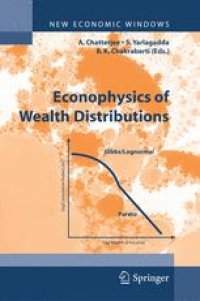
Ebook: Econophysics of Wealth Distributions: Econophys-Kolkata I
- Tags: Economics general, Statistical Physics Dynamical Systems and Complexity
- Series: New Economic Windows
- Year: 2005
- Publisher: Springer-Verlag Mailand
- Edition: 1
- Language: English
- pdf
Understanding the distribution of income and wealth in an economy has been a classic problem in economics for the last hundred years. Apart from the rapidly decaying number density of people with their income crossing over to a robust power law for the very rich, known as the Pareto power-law, after Vilfredo Pareto. With the availability of accurate data from finance/income-tax departments of various countries, several robust features of the income distribution have been established.
This field had been dormant for more than a decade, although accurate data had been accumulated over this period. The recent enthusiasm comes mainly from the physicists modelling of markets in analogy with physical systems like gases etc. This is the first book reporting exhaustively on these developments over the last decade by leaders in the field
The book will report on the major models developed mainly by the (econo-) physicists over the last decade. Almost all the major physicists and economists involved in these studies will review their latest work and the associated developments.
Understanding the distribution of income and wealth in an economy has been a classic problem in economics for the last hundred years. Apart from the rapidly decaying number density of people with their income crossing over to a robust power law for the very rich, known as the Pareto power-law, after Vilfredo Pareto. With the availability of accurate data from finance/income-tax departments of various countries, several robust features of the income distribution have been established.
This field had been dormant for more than a decade, although accurate data had been accumulated over this period. The recent enthusiasm comes mainly from the physicists modelling of markets in analogy with physical systems like gases etc. This is the first book reporting exhaustively on these developments over the last decade by leaders in the field
The book will report on the major models developed mainly by the (econo-) physicists over the last decade. Almost all the major physicists and economists involved in these studies will review their latest work and the associated developments.
Understanding the distribution of income and wealth in an economy has been a classic problem in economics for the last hundred years. Apart from the rapidly decaying number density of people with their income crossing over to a robust power law for the very rich, known as the Pareto power-law, after Vilfredo Pareto. With the availability of accurate data from finance/income-tax departments of various countries, several robust features of the income distribution have been established.
This field had been dormant for more than a decade, although accurate data had been accumulated over this period. The recent enthusiasm comes mainly from the physicists modelling of markets in analogy with physical systems like gases etc. This is the first book reporting exhaustively on these developments over the last decade by leaders in the field
The book will report on the major models developed mainly by the (econo-) physicists over the last decade. Almost all the major physicists and economists involved in these studies will review their latest work and the associated developments.
Content:
Front Matter....Pages I-IX
Front Matter....Pages 1-1
Pareto’s Law of Income Distribution: Evidence for Germany, the United Kingdom, and the United States....Pages 3-14
Two-class Structure of Income Distribution in the USA: Exponential Bulk and Power-law Tail....Pages 15-23
Pareto-Zipf, Gibrat’s Laws, Detailed-Balance and their Breakdown....Pages 24-33
Empirical study and model of personal income....Pages 34-42
Blockbusters, Bombs and Sleepers: The Income Distribution of Movies....Pages 43-47
Front Matter....Pages 49-49
Emergent Statistical Wealth Distributions in Simple Monetary Exchange Models: A Critical Review....Pages 51-60
Lagrange Principle of Wealth Distribution....Pages 61-69
Carnot Process of Wealth Distribution....Pages 70-78
Ideal-Gas Like Markets: Effect of Savings....Pages 79-92
Kinetic Theory Models for the Distribution of Wealth: Power Law from Overlap of Exponentials....Pages 93-110
Detailed Simulation Results for Some Wealth Distribution Models in Econophysics....Pages 111-119
Dynamics of Money and Income Distributions....Pages 120-125
Dynamic Process of Money Transfer Models....Pages 126-136
A Stochastic Trading Model of Wealth Distribution....Pages 137-148
Wealth Distribution in a Network with Correlations Between Links and Success....Pages 149-158
The Monomodal, Polymodal, Equilibrium and Nonequilibrium Distribution of Money....Pages 159-167
Relieving Poverty by Modifying Income and Wealth Distributions....Pages 168-176
The Rich Are Different ! Pareto Law from Asymmetric Interactions in Asset Exchange Models....Pages 177-183
Do We All Face the Same Constraints?....Pages 184-191
Front Matter....Pages 193-193
A Stochastic Model of Wealth Distribution....Pages 195-198
Front Matter....Pages 193-193
How the Rich Get Richer....Pages 199-204
Power-Law Distribution in an Emerging Capital Market....Pages 205-209
Statistical Analysis on Bombay Stock Market....Pages 210-213
Funds Management by Banks in India: Solution to a Persisting Optimization Problem....Pages 214-217
Income Distribution in the Boltzmann-Pareto Framework....Pages 218-222
Front Matter....Pages 223-223
Econophys-Kolkata: A Short Story....Pages 225-228
Econophysics of Wealth Distribution: A Comment....Pages 229-238
Econophysics of Wealth Distributions: Workshop Summaries....Pages 239-245
Back Matter....Pages 246-248